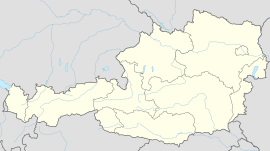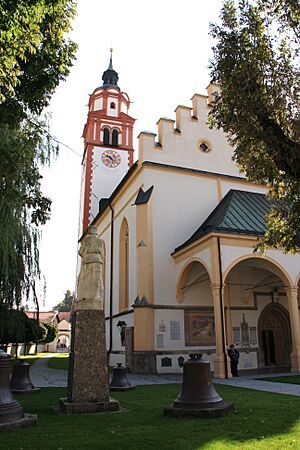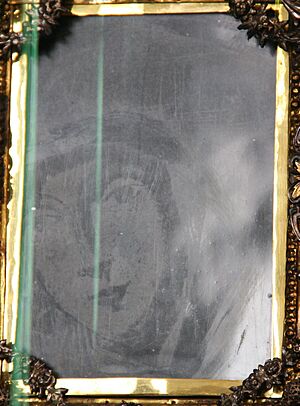Absam facts for kids
Quick facts for kids
Absam
|
||
|---|---|---|
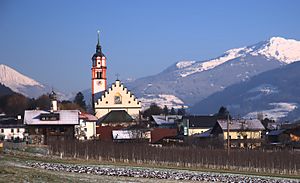 |
||
|
||
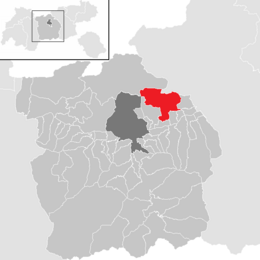
Location in the district
|
||
| Country | Austria | |
| State | Tyrol | |
| District | Innsbruck Land | |
| Area | ||
| • Total | 51.93 km2 (20.05 sq mi) | |
| Time zone | UTC+1 (CET) | |
| • Summer (DST) | UTC+2 (CEST) | |
| Postal code |
6067
|
|
| Area code | 05223 | |
| Vehicle registration | IL | |
| Website | www.absam.at | |
Absam is a town in Tyrol, Austria. It's located in the Innsbruck-Land District. The town sits at an altitude of 632 meters (about 2,073 feet). As of January 2015, Absam had 6,776 people living there. Its total area is 51.92 square kilometers (about 20 square miles).
Contents
Geography of Absam
Absam is located about 15 kilometers (9 miles) from Innsbruck. It's in the lower Inn Valley, which is called Unterinntal. The town is on the slopes of the Zunterkopf Haller mountains. It is just north of Hall in Tirol. You can reach Hall in Tirol using the regional road L 225. Road L 372 connects Absam to Innsbruck. This road goes through Mühlau, Arzl, Rum, and Thaur.
You can also get to Absam by bus from Innsbruck. Bus lines D and E serve the village. The highest point in Absam is the Große Bettelwurf mountain. Its summit is 2,775 meters (9,104 feet) high.
Absam shares borders with several other towns. These include Baumkirchen, Fritzens, Gnadenwald, Hall in Tirol, Innsbruck, Mils, Tyrol, Scharnitz, Thaur, and Vomp.
History of Absam
Early Beginnings
It's not fully clear when people first settled in Absam. However, some old items have been found there. These include a sword part and a copper brooch. They date back to about 1500 BC. This shows that people lived here a very long time ago.
Even though the Romans took over Tyrol in 15 AD, not many Roman settlement signs have been found. One Roman coin from the time of Diocletian was discovered. The name "Abazanes" comes from the Roman period. This name later became Absam. The town was first mentioned in a document in 995. This document is kept by the Diocese of Brixen. At that time, the Bishop of Augsburg owned much of the land.
In 1282, Absam was part of the Thaur parish. This parish covered the whole region. The name "Abzan" appeared in land records in 1288. By the 1300s, Absam was mentioned many times in documents. On September 21, 1331, Absam's church became its own parish. Before that, it was connected to Thaur.
Salt Mining and Industry
Absam is in an area known for salt mining. This includes nearby Hall in Tirol and Thaur. Salt mining was a big source of money for the rulers back then. Records show that mining started in 1232. Salt production was at its highest between the 1500s and 1600s. In 1615, 547 workers were employed in salt mining. They earned good wages, which helped the town's economy grow.
At the same time, Absam started to become more industrial. The Baubach stream provided energy for factories. Sawmills, forges, and mills opened. Coppersmiths also became important. One company, Oswald Kofler, made 15,000 copper sheets. These were used for the roof of the church in Schwaz. In 1809, during a local uprising, 73 shooters from Absam joined the troops.
In 1845, Absam's first factory opened. It was a spinning and weaving company called Faistenberger. More factories followed, like a foundry and chocolate, boot, and paint factories. A metal workshop also opened. This helped Absam's industry grow. Meanwhile, salt mining started to decline. New ways of getting salt and lower prices worldwide led to this. Salt mining in Tyrol finally stopped on September 5, 1967.
The Swarovski company moved its Optik (optics) department to Absam in 1949. This happened in the Eichat neighborhood. During World War II, a military barracks was built there.
Population
| Historical population | ||
|---|---|---|
| Year | Pop. | ±% |
| 1869 | 1,256 | — |
| 1880 | 1,262 | +0.5% |
| 1890 | 1,242 | −1.6% |
| 1900 | 1,482 | +19.3% |
| 1910 | 1,956 | +32.0% |
| 1923 | 2,114 | +8.1% |
| 1934 | 2,473 | +17.0% |
| 1939 | 3,456 | +39.7% |
| 1951 | 3,885 | +12.4% |
| 1961 | 4,640 | +19.4% |
| 1971 | 5,361 | +15.5% |
| 1981 | 5,402 | +0.8% |
| 1991 | 5,834 | +8.0% |
| 2001 | 6,362 | +9.1% |
| 2011 | 6,700 | +5.3% |
| 2015 | 6,776 | +1.1% |
Coat-of-arms
The coat-of-arms of Absam is divided into four parts. One part shows the face of the Virgin Mary. This represents a special event that happened in 1797. Another part shows a violin on a gold background. This is to remember Jakobus Stainer, a famous violin maker. He lived in Absam. The town officially adopted this emblem on July 20, 1965.
Sights to See
Religious Buildings
Basilica of St. Michael the Archangel
The church of St. Michael the Archangel was first mentioned in a document on September 21, 1331. It was made a parish church by the Bishop of Brixen. In 1413, the church was destroyed during an invasion. Its rebuilding started in 1420. Hans Sewer from Hall in Tirol led the work. The church was rebuilt in a late Gothic style. It had three naves (main parts) and columns. The reconstruction was finished in 1440.
Two important artworks are from this time. One is an altarpiece from 1470. It shows the Madonna with four women and a crucifix. The other is a crucifix called Fiegersche, from 1492. In 1670, an earthquake damaged the church's bell tower. It was rebuilt in 1677. The old pyramid roof was replaced with a dome. In 1871, the church roof was covered with copper plates. In 1779, the church was renovated inside. It was decorated in the Rococo style with frescoes by Josef Anton Zoller.
The Miraculous Windowpane
On January 17, 1797, an image of the Virgin Mary appeared on a glass window. This happened at the house of a farmer named Rosina Buecher. On June 24, 1797, this special window was moved to the church. After this, the church became known as the Maria Absam Sanctuary.
On June 24, 2000, the church was given the title of a Basilica. This day is also the feast day of St. John the Baptist, who is the village's second patron saint. Absam's church became the first sanctuary in Tyrol to be called a Basilica without having a monastery attached to it.
Notable People
- Josef Feistmantl (born 1939): a famous luger (someone who rides a small sled)
- Franz Fischler (born 1946): a politician
- Jacob Stainer: (born 1619): a luthier (someone who makes stringed instruments like violins)
- Max Weiler (born 1910): a painter
Economy
Industries in Absam
Absam is home to Swarovski Optik KG. This company was started in 1935 by Wilhelm Swarovski. He found a way to make lenses and prisms very smooth. He used this method to create binoculars. Their first product, the "Habicht 7 x 42" binoculars, is still made today. It is mainly used for hunting. Swarovski Optik also makes other cool things. These include telescopes, rifle scopes, and special optical tools. They also make devices that help you see in the dark.
See also
 In Spanish: Absam para niños
In Spanish: Absam para niños



